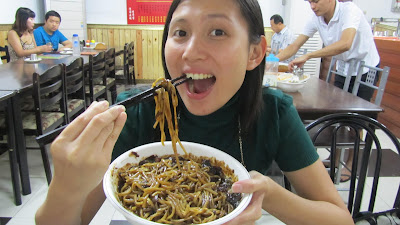I’m quite a fortunate girl. You see, David enjoys going for an adventure too, and
he likes taking me to these “not-so-secret” restaurants. These are food places that are quite
hidden, yet still popular enough to have frequent loyal clients.
I love love love Korean food. The mix of sweet and spicy dishes, crunchy and chewy
textures, cold and warm appetizers, play in my mouth like fireworks. So for our first not-so-secret
restaurant, David asked the recommendation by no other than his Korean
officemate. Of course, we should
eat where the real Koreans eat right?
His officemate told him about a hidden restaurant in Kalayaan
Avenue. This restaurant is popular
for their black noodles.
It was one Sunday noon time, we were driving along Kalayaan
ave. and we were looking at all the Korean restaurants nestled beside each
other. We drove back and forth. He told me the name sounded like “Chang..”
something.
We drove to the other Korean restaurants and asked if they offer black
noodles. Fortunately, there was
one restaurant that pointed us to Jjang Kae, one block away. It's the one with yellow background.
To enter the restaurant, you have to walk through a hallway to the far end of
the building.
Jjang Kae is a
casual food place, with wooden tables and chairs. On the tables are white
ceramic plates with aluminum tea cup, silver spoon and black plastic
chopsticks. Cold water in plastic
bottles are also placed conveniently on each table.
Like in any Korean restaurant, Jjang Kae serves appetizers
for free before the orders are delivered.
We had slices of pickled yellow radish and raw onions. This is the same radish that the Japanese
place in their sushi. When dipped
in the black bean paste sauce, the radish tastes slightly salty, savory and
refreshing at the same time.
For our main meal, we ordered what David’s Korean officemate
had suggested: Jjajang-Myeon.
Jjajang-Myeon is noodles topped with stir-fried black bean paste and
vegetables. They have other
variations; Ganjjajang if you’d like to add some pork meat and Samsun-Jjajang for seafood.
Upon serving our Jjajang-Myeon (Php 220) and Samsun-Jjajang (Php 250), the server cut the noodle strands using a pair
of scissors. She then mixed the
black sauce with the noodles using chopsticks.
The noodles were oh so chewy! I can still remember how soft, yet firm, each noodle strand was in my mouth. The texture reminds me of Japanese noodles. The taste is a bit sweeter than the bean paste used in the appetizer. It has a sweet fragrant of garlic, onion and vegetables too.
David thought it somehow resembles the Chinese Ho-Fan (flat noodles), but a lot less salty and a whole lot less oily. Yep, definitely better than Ho-Fan. I get easily satiated with Ho-fan, perhaps because of the oil. But for the Jjaujang-Myeon, I ate to my heart's desires.. or until my stomach was filled to the brim.
The serving size for a Php 220-250 worth of noodles was really big! According to the server, usually each customer orders one bowl of noodles. But we realized, it can be big enough for sharing too. We also tried their gyoza (Php 200 for 8 pieces). I found it very dry and flaky.
I will definitely come back to Jjang Kkae Restaurant if and when I have a sudden craving for Korean noodles, or noodles in general. Gun Bae! :)
Jjang Kkae Restaurant
Kalayaan Avenue QC. (after City Hall)











Tell me if their Bibimbap is also good. Nice eating Mitzi! :-)
ReplyDeleteThey don't have Bibimbap there Marie. I initially looked for it too. :)
ReplyDeleteBoth of you look so cute Joyce dear, let's go eat Korean food together next tome ^0^
ReplyDeleteThank you Momo dear! Yes, let's!!! :)
ReplyDelete